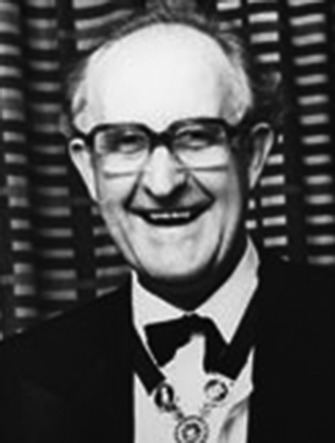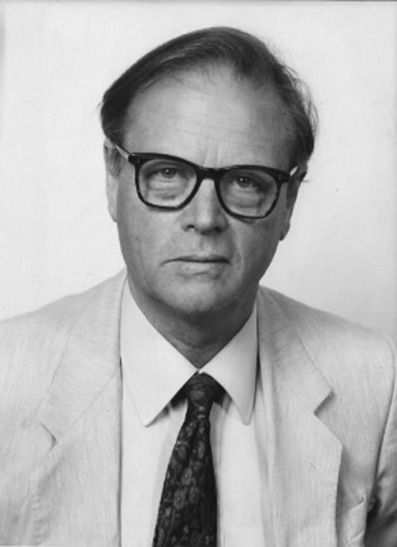The world of radiation biology, and indeed the British Institute of Radiology (BIR), lost two of its most distinguished scientists in 2016 with the passing of both Professor Jack Fowler and Sir Oliver Scott. Jack Fowler served as President of the BIR from 1977-1978, and both men were past editors of BJR, both were awarded honorary fellowships of the BIR and both held the position of Director of the Gray Laboratory in the course of their distinguished careers. Here, we pay tribute to their lives.
PROFESSOR JOHN FRANCIS “JACK” FOWLER, DSc, (1925–2016)

Professor John Francis “Jack” Fowler was an eminent medical physicist turned radiation biologist, greatly respected and admired in all countries which use radiation in the treatment of cancer. He served as Director of the Cancer Research Campaign's Gray Laboratory at the Mount Vernon Hospital, Northwood, between 1970 and 1988, when its scientific output was extensive and world-leading. He was totally devoted to studying radiation effects in biology and medicine—his massive research output encompassed almost every aspect of this difficult interdisciplinary subject. His greatest contribution was to the understanding of the processes that underpin the relationships between overall treatment time, dose per daily treatment and the number of such treatments in radiotherapy. His publications and experimental data in this area alone have undoubtedly led to safer radiotherapy with reduction in unwanted adverse reactions in the irradiated normal tissues, and also to improved cancer eradication.
Jack was born in Dorset (1925) and was nurtured by his schoolteacher mother and by his father, an inventor of gadgets. At the age of only 19, he obtained a London University Physics first-class degree, but worked in industry between university terms, including Spitfire instrumentation at Castle Bromwich. He then worked for Metropolitan Vickers on defence-related radiation accelerator projects, but he opposed the development of a larger hydrogen bomb. He abandoned physics to join a theatre group for 2 years, after they had impressed him with a play called “Uranium 235” in Manchester. This was Joan Littlewood's famous touring Theatre Workshop. He became their stage manager, handled the voltages of the lighting and did some small stage parts. This experience taught him that he had stamina for long hours, sometimes working overnight, as well giving him presentational skills, which he later fully employed in lectures throughout the world.
He then chose a career in medical physics and was trained in Newcastle by Frank Farmer, who contributed so much to developing accurate dosemeters and improving national standards. Appointments followed in London at King's College Hospital, St Bartholomew's Hospital (as reader), and then as Head of Physics, MRC Radiotherapeutics and later the Cyclotron Unit in the Hammersmith Hospital, which gave him access to fast neutrons and alpha particles for research purposes.
He followed the path of LH Gray (after whom the unit of radiation absorbed dose is named) and other scientists moving from Hammersmith to Mount Vernon, so taking over the directorship of the Gray Laboratory following Sir Oliver Scott. He built on the good foundations established by his predecessors and the laboratory expanded to cover a wide range of research from fundamental biochemical interactions to end points of tumour control and normal tissue effects in experimental systems, which are so important for devising new schedules of radiotherapy for patients with cancer. He was in great international demand as a lecturer, advisor and coauthor. His theatrical skills were extended to his whole team in meticulously conducted rehearsals of scientific presentations at national and international meetings. His prolific output and success owed much to his preference for keeping matters as simple as possible; his background also ensured that he could explain complex mechanisms to medical doctors, physicists, chemists and biologists using plain English and with perfect timing.
After retirement, he held research appointments at many universities, most notably Madison (USA) and Leuven (Belgium). Prizes and honorary degrees were frequent, including the BIR's own Barclay Medal and Röntgen Prize, and he continued publishing until the grand old age of 89. Outside of work, his interests included ballroom dancing and getting into the countryside, especially to visit exhibition fairs of old steam engines.
Jack died peacefully on 1 December 2016, at home with his wife Anna.
SIR OLIVER CHRISTOPHER ANDERSEN SCOTT, MD, FRCR, 3RD BARONET SCOTT OF YEWS (1922–2016)

Sir Oliver Scott, 3rd Baronet Scott of Yews, was a distinguished scientist and the greatest benefactor that radiobiology has known. He inherited the baronetcy after his brother was killed in action in 1942, which had considerable repercussions for radiobiology. His grandfather had created a medical research trust, which Oliver much enlarged; these resources were used to create what eventually became known as the Gray Laboratory.
This charitable act effectively rescued the career of his greatly admired mentor and collaborator LH (“Hal”) Gray, who had been dismissed suddenly as Director of Physics in the Hammersmith Hospital following an argument with its clinical director about the suitability of neutron therapy for cancer. At Mount Vernon Hospital, the new laboratory became the world-leading centre for radiobiology research. Oliver and many other eminent scientists such as Jack Boag developed new techniques, such as pulsed radiolysis, to study oxygen effect kinetics, and they explored almost the entire spectrum of radiobiology research.
Oliver's academic career commenced by reading natural sciences at King's College, Cambridge, after which his father advised him to study medicine at St Thomas' Hospital. This he did with his friend Hugh Thomlinson, who with Gray later went on to identify hypoxic areas in human tumours. Oliver then worked in Addenbrooke's Hospital, Cambridge, with Professor Sam Mitchell, who was convinced that cancers could be radiosensitized using vitamin K. National service as surgeon-lieutenant in the Royal Naval Volunteer Reserve resulted in Oliver gaining experience of high-pressure oxygen (HPO) administration for submariners. Afterwards, he approached several leading cancer specialists in London with the idea that HPO might be used with radiotherapy for cancers containing necrotic hypoxic areas. Only Gray, a physicist, understood his thesis. At the Hammersmith Hospital, they quickly proceeded with elegant experiments that unequivocally showed that HPO reduced the required dose to sterilize transplanted cancers in mice by a factor of around 2. They even started research to find chemical substitutes for oxygen, and many hospitals adopted HPO. He concluded that, although effective, it was very time consuming and so, other approaches were necessary. Further contributions included identification of stem cell populations in the skin, elimination of the effect of transplantation antigens in animal tumour models, the use of multiple treatments per day to treat faster growing tumours and also how best to approach the mathematical modelling of radiotherapy.
After Gray died, Oliver became laboratory director; but, after a few years, he developed severe hypertension and passed the directorship on to Jack Fowler. He later held other consultative appointments and a lectureship at his old medical school, but always maintained an interest in the laboratory, being a frequent visitor, advisor and continuing benefactor. He was exceptionally kind and helpful to PhD students and would sometimes award grants for their post-doctoral work. When radiation research became unfashionable in the 1990s, and funding more difficult to obtain, he repeatedly made substantial donations to the laboratory and he supported many forms of research activities elsewhere, often without acknowledgement (at his own behest). He also played an important role in the PUGWASH antinuclear weapons group and helped Russian clinical scientists, making risky journeys to plead on their behalf. Many other humanitarian interventions were initiated by him.
Cambridge University awarded him the MD degree for submission of research studies in 1974 and later, he was awarded the FRCR and Honorary Membership of the BIR, having previously served on committees and as editor of the journal.
Oliver was charming, highly intellectual, quiet but persuasive and had other interests in poetry, languages, music and the society of his happy family. Many regard him as the last of the gentlemen scientists, who used their personal wealth to explore science and patronize the arts for the benefit of mankind.


